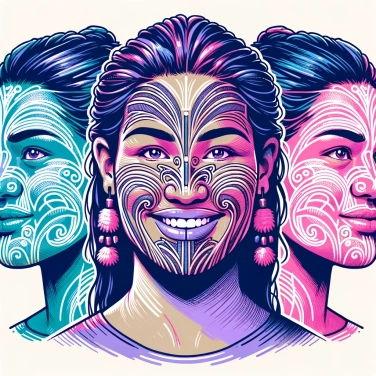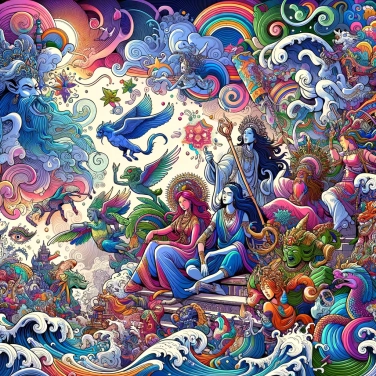Maoris place great importance on traditional facial tattoos called "moko" as they are seen as marks of prestige, tribal identity, and connection to their ancestors. These tattoos also represent social status, courage, and strength of the person who is tattooed.

For the Maoris, moko comes from ancestral legends and is of divine origin. According to their tradition, facial tattooing was brought to humans by Mataora, a legendary warrior who learned the art of moko in the spiritual world. The moko is seen as sacred, connecting the tattooed person to their ancestors and the spiritual realm. These patterns are not just decorative: filled with mana (spiritual power and prestige), they protect and guide the wearer. The face is particularly important in this culture, as it is considered a direct reflection of the individual's soul (wairua).
For the Maori, the moko is much more than just a tattoo: it is a powerful representation of their personal and community identity. Each design drawn on the face is unique and tells a story or individual journey: family, ancestors, tribe, and even personality. Essentially, thanks to these specific symbols, one can quickly know a person's origin and what they have experienced or accomplished. On a collective level, the moko reinforces the sense of belonging to the community and the bond between its members. Therefore, for each tattooed individual, displaying their moko is a proud affirmation of their Maori identity, their roots, their values, and their place within the group.
Among the Maoris, moko is not tattooed randomly: each symbol tells a personal story, like a map detailing the achievements and qualities of the person wearing it. The more precise and complex your moko is, the more it reflects your prestige, your value, and your place in society. For example, certain specific patterns indicate acts of bravery, particular skills, or important roles within the community (such as chief, warrior, or spiritual specialist). A facial moko is so rich in meaning that just by seeing it, one can quickly understand who you are, what you have accomplished, and your importance in the community. In traditional times, obtaining certain facial tattoos represented a huge honor, reserved only for those who had truly proven themselves.
Among the Maoris, moko are not just simple tattoos; they tell a whole story, that of ancestors and traditions. Each design on the face has a particular meaning, passed down from one generation to the next by the elders to the younger ones. This practice, carried out by the tohunga-tā-moko (expert tattooists), represents a true oral and gestural transmission of knowledge about the history, genealogy, and beliefs of the Maori people. Through moko, ancestral know-how and foundational narratives remain alive and continue to be shared, directly contributing to the active preservation of their cultural heritage.
Today, moko are experiencing a real resurgence of interest among the Maoris. Many choose to get tattooed using traditional techniques to show their cultural pride and reaffirm their Māori identity. It also serves to remind everyone that their heritage is still alive and relevant, not just a thing of the past. Wearing a moko has become a tangible way to express both respect for one’s ancestors and a desire for grounding in today’s society. This movement of renewal also helps raise awareness among younger generations about their roots while sending a clear message to society: Māori identity is present, embraced, strong, and proud.
Each motif and line of the moko has a specific meaning: some patterns symbolize personal achievements, while others represent family lineages, tribal connections, and spiritual ties.
The traditional Maori "moko" was created not with a needle, but by engraving the skin using bone or stone chisels, then colored with natural pigments, making each tattoo unique in texture.
Historically, facial moko among the Māori was so personal that some chiefs used their moko as a signature for official documents, including during the Treaty of Waitangi in 1840.
The female facial moko, known as "moko kauae," is typically tattooed on the chin and symbolizes lineage, spiritual strength, and ancestral knowledge among Māori women.
Among the current challenges are commercialization and cultural appropriation, tensions arising from the growing interest of the non-Māori public. Practitioners of traditional moko emphasize the importance of respecting deep cultural meanings, protocols ('tikanga'), and recognizing moko as a living heritage rather than merely an aesthetic trend.
Yes, in Māori culture, male and female tattoos traditionally differ. Male moko generally covers the entire face and represents the social status, personal history, and achievements of the wearer. Women traditionally wear moko kauae, which primarily focuses on the chin and symbolizes their familial and tribal identity, their ancestors, and their status within the community.
In principle, traditional moko have a deep cultural significance reserved exclusively for the Māori community. However, some Māori tattoo masters occasionally agree to create tattoos inspired by the moko style for non-Māori individuals, while clearly emphasizing that these are not authentic traditional moko.
Traditionally, the moko was applied by an expert known as 'tohunga tā moko' using typical tools such as bone chisels and natural pigments made from soot and other plant materials. Today, while some use modern techniques, many Māori prefer to preserve these traditional methods to stay true to their cultural heritage.
Moko designs generally tell personal, familial, and tribal stories. They often symbolize genealogy ('whakapapa'), achievements, spirituality, as well as the deep connections maintained with the land ('whenua') and ancestors ('tīpuna'). Each moko is unique and expresses the distinct identity of the person who bears it.

No one has answered this quiz yet, be the first!' :-)
Question 1/5